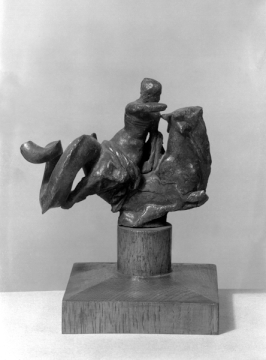Explore Collections


You are here:
CollectionsOnline
/
A Roman bronze figure of a nereid (sea nymph) riding on a sea bull
Browse
SM X105. ©Sir John Soane's Museum, London. Photo: Justin Piperger
Curatorial note
A female figure clad in a himation draped about her lower limbs and over her left arm, which supports her weight on the beast's back, sits to the right on a bull whose body terminates in a curling sea-serpent's tail. She also wears a small plain band about her chest, and while seated towards the rear so that her right foot touches the coiled tail, her head and shoulders are turned to the left or forward. Her right arm is raised and extended in the direction of her gaze. The casting at the base indicates that the bull is to be imagined as swimming rapidly through the water.
There are two possible identifications of subject in this small group: the more common nomenclature for a female, nude or partially draped, riding on a sea-bull is a Nereid. From the numerous statuary, sarcophagus, and other representations of Nereids and Erotes on sea-bulls and other beasts (see above, Soane no. 364; O p. 41) and for lack of other attributive evidence, this would appear as the designation for this bronze1. In the particular case of Nereids on sea-bulls, however, we are confronted with the possibility that the subject may be intended as Europa on the Bull, with the marine aspect of Zeus's disguised voyage stressed in giving the bull a marine tail. A.B. Cook2 makes out an excellent case for Europa on the Bull as the subject of a Roman second century AD mosaic from Aquileia and a similar scene appears on a cameo in Paris3. If the cameo could equally well show Aphrodite or Amphitrite, the mosaic, with its details of Eros with torch and the nuptual garland, definitely seems to indicate Zeus's abduction of Europa4. The Nereid on a sea bull appears in all manners of Roman decorative art, amongst which is an uncommon group on a terracotta lamp in the British Museum5.
1 For the artistic significance of Nereids on sea-beasts, see A. B.Cook, Zeus, III, p. 132ff.
2 op. cit., p. 627, pl. XLVIII.
3 Reinach, RR, II, p. 235, 4; Babelon, Camées, no. 115, pl. XII.
4 Brusin, Aquileia, p. 111ff., no. 56; fig. 65 shows the extent that Cook's plate is restored.
5 Walters, BM, Lamps, no. 628, pl. XXI, also pl. XLII, shape 81, 100/100 BC-AD.
There are two possible identifications of subject in this small group: the more common nomenclature for a female, nude or partially draped, riding on a sea-bull is a Nereid. From the numerous statuary, sarcophagus, and other representations of Nereids and Erotes on sea-bulls and other beasts (see above, Soane no. 364; O p. 41) and for lack of other attributive evidence, this would appear as the designation for this bronze1. In the particular case of Nereids on sea-bulls, however, we are confronted with the possibility that the subject may be intended as Europa on the Bull, with the marine aspect of Zeus's disguised voyage stressed in giving the bull a marine tail. A.B. Cook2 makes out an excellent case for Europa on the Bull as the subject of a Roman second century AD mosaic from Aquileia and a similar scene appears on a cameo in Paris3. If the cameo could equally well show Aphrodite or Amphitrite, the mosaic, with its details of Eros with torch and the nuptual garland, definitely seems to indicate Zeus's abduction of Europa4. The Nereid on a sea bull appears in all manners of Roman decorative art, amongst which is an uncommon group on a terracotta lamp in the British Museum5.
1 For the artistic significance of Nereids on sea-beasts, see A. B.Cook, Zeus, III, p. 132ff.
2 op. cit., p. 627, pl. XLVIII.
3 Reinach, RR, II, p. 235, 4; Babelon, Camées, no. 115, pl. XII.
4 Brusin, Aquileia, p. 111ff., no. 56; fig. 65 shows the extent that Cook's plate is restored.
5 Walters, BM, Lamps, no. 628, pl. XXI, also pl. XLII, shape 81, 100/100 BC-AD.
Unrecorded.
Soane collections online is being continually updated. If you wish to find out more or if you have any further information about this object please contact us: worksofart@soane.org.uk







